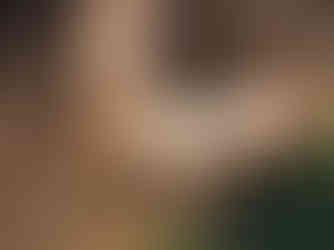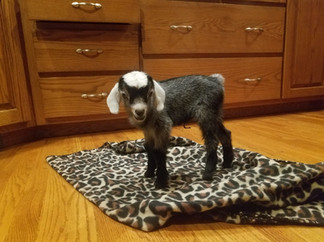Hair Loss in Goats
- Kendra R. Shatswell
- Jan 3, 2022
- 7 min read
Updated: Jan 12, 2024
Alopecia, more commonly known as hair loss, can have several causes.
A goat's coat is made up of an outer layer of long guard hairs and an undercoat of cashmere that serves as insulation. The length and texture of the guard hairs and the abundance of undercoat can vary from animal to animal, breed to breed, and season to season. Some animals have noticeably little to no undercoat. Goats grow longer/thicker coats in the fall and shed in the spring.
Frictional Alopecia
Sometimes, it is as simple as the goat rubbing the hair from its nose on the feeder. The first freshener Kinder and miniature LaMancha doe pictured here are good examples. The rest of their hair coats are exceptionally healthy, and they has no external parasites - they are simply sticking their faces way into the 4x4 panel hay feeder pictured and rubbing the hair from the bridge of their noses. Roman noses tend to exacerbate this issue. In winter, the goats spend ample time in front of the hay feeders, so this hair loss might be noticeable only seasonally.
Bucks (and sometimes even wethers) in rut are notorious for developing bald patches, usually on their heads and necks. Males scrub on one another and fences and other structures, wreaking havoc on their hair coat. Since they urinate on themselves with wild abandon, they can also develop urine scald which results in hair loss on their legs and even muzzle. Couple this with increased zinc requirements and wa-la, balding bucks. The two below are good examples. The younger buck had recently been sparring, too. Urine scald can be (mostly) prevented by a good buck shield or apron - Narrow Gate Nigerian Dwarf farm Facebook page here has some great examples - video here. Clipping long leg hair before rut is also a good idea, since it will mean there's less hair to soak up urine and hold it next to the skin. For bucks already dealing with this self-inflicted malady, try washing the legs with mild soap and applying petroleum jelly or even diaper cream, something water-repellant.
External Parasites
Hair loss can also be caused by mites or lice - lice are especially prevalent in winter. Lice can be difficult to see, especially in the thick winter coats. Try brushing the hair backwards with your hand and examining the skin for lice, especially along the shoulders and rump, areas that are harder for the goats to scratch and so are a favorite of those pesky external parasites. Lice can be tiny yellow or slightly larger and flat and striped – these are biting lice. The most common sucking (this means they feed on blood whereas biting lice feed on skin debris) lice are blue gray with fat bodies and tiny red heads. The sucking lice might be easier to see on light-colored goats while the biting lice are usually more noticeable on darker animals. Biting lice often lay eggs around horns or horn buds and the face, especially on kids. These eggs will be tiny, stationary specks attached near the bottom of the hair shafts. More information on lice in an upcoming post! Hair loss around the legs or feet might be mites/mange. Diagnosis is best done with a skin scrape or plug. More on this in an upcoming post.
Nutritional Factors Contributing to Alopecia Hairless or thin-haired newborns might be the result of being iodine deficient. These kids are usually dead on arrival and sport enlarged goiters at their throat latches.
Bald spots or poor quality coat might also be the result of an overall poor diet, mineral deficiencies, toxicities or imbalances. Common mineral issues include zinc deficiency or a zinc to copper imbalance. Zinc is crucial to healthy hair as it is required by proteins that make up the hair shaft. Copper is essential to melanin production, so affects color. Read more about that here, here, and here.
As far as a general lack in the diet, I think this quote sums it up nicely: "A goat subject to deficiencies in dietary energy or protein can be expected to have a dry, sparse hair coat and dry, thin, scaly skin." (Smith and Sherman 47).
According to Goat Medicine, selenium toxicity has been associated with alopecia , especially when consuming plants high in selenium. In one case, the only evidence was a rough hair coat and in another it was thought selenium excess was the cause of hair loss involving the "beard and flank region" ( Smith and Sherman 49). Frustratingly, selenium/vitamin E deficiency can also cause issues: "Periorbital alopecia (with mild scaling) is often prominent in Vitamin E or selenium responsive dermatosis and alopecic exfoliative dermatitis" (Smith and Sherman 27). In simpler terms, goats suffering from skin issues caused by selenium/Vitamin E deficiencies OR from dermatitis caused by an allergic sort of reaction might have hair loss around the eyes.
Sulfur deficiency might cause alopecia and even "fleece-eating" in cashmere goats (Smith and Sherman 49). Note that hair goats have higher requirements than other breeds, so you are most likely to see this issue only in cashmere types or Angoras.
To a lesser extent than the aforementioned minerals, a lack of vitamin A might contribute to hair loss but is more likely noticeable as a rough hair coat. According to Sheep and Goat Medicine by Pugh, vitamin A is responsible for "epithelial (skin) tissue integrity." Forage usually contains adequate vitamin A but poor quality hay or hay that has been stored for a long period of time will be deficient. Even in supplements, vitamin A is easily lost, especially if the supplement also contains "oxidizing agents (e.g. copper, iron)" (Pugh 23).
Skin Issues
Missing hair limited to the hooves could be from hoof rot. Hoof rot is infectious, caused by several types of bacteria and more likely in warm, wet weather (Pugh 272). Ringworm is a contagious fungal infection that damages hair and skin as it grows then also causes itching, resulting in more damage (Pugh 231).
Other Causes Other possible causes include “stress-break” – more common in hair goats but possible in other breeds – or hair loss due to high and/or prolonged fever – this is especially noticeable in kids. Frostbite, especially on ears, can result in hair loss. It is possible that sunburn, especially on white animals, can cause alopecia but you are more likely to see this in areas where hair is thin already. Certain plants like lantana cause photosensitivity in goats (Smith and Sherman 49). Some topicals (usually treatments for external parasites) can cause skin irritation and hair loss. Dehorning paste, especially if the kid is allowed to move freely while the paste is applied, might also cause hair loss as well as damage to eyes and udders. (It is my personal opinion that disbudding is more humane than the paste because it is a MUCH faster process.)
Premature kids might be hairless (DOA if they are this early) or have very fine, thin hair. Preemies require intensive care and are quite fragile. This is a good time to remind folks to write down dates, too, whether when you turn in a buck and take him out or when you know a doe is bred.
*PHOTOS AT THE BOTTOM OF THE POST. GRAPHIC PHOTO OF DECEASED PREEMIE KIDS*
Final Thoughts While these are not the only reasons goats might be missing hair, these are the most common issues breeders deal with.
It is important to try to determine WHY the hair is missing, but even with successful lice treatments or supplementing a mineral et cetera, the goat's hair STILL may not grow back for some time, especially if the issue occurs during winter. Still-missing hair doesn’t necessarily mean treatment didn’t work; it might mean the hair just needs more time to grow back.
This is because hair grows in a cycle. Hair typically does NOT grow in the winter - this phase is called telogen. It is the "resting" phase and is controlled by several factors but season is a big one! Additionally, hair in the telogen phase is "more easily lost or pulled out." - Sheep, Goat, and Cervid Medicine by Dr. Pugh page 221. So, try to determine the cause and treat accordingly, but patient with those winter bald spots in your herd. Note that it is possible that severe scarring can lead to permanent hair loss. When evaluating hair loss, look at the simplest explanation first - could it be frictional alopecia? How many animals are affected? Check for external parasites. What season is it? Then evaluate the goats' diet, especially your mineral program.
Top left - very premature kids, alive only for a few minutes. Note they are nearly hairless, with just "peach fuzz." Photo courtesy of Lucy Lambeth. Top right - Kara, a triplet born nearly 3 weeks early, with two DOA siblings. Note that she has her coat, but it is very fine. Photo courtesy of Rebecca VanTassle. Bottom left - ZCG Blue Velvet as newborn, a few days early. Her teeth hadn't yet erupted and she required syringe feeding for the first few days. Today, she is a fat, sassy girl due to kid in February! Photo courtesy of Alicia Weaver. Bottom right - Pebbles and BamBam, miniature LaMancha twins born 9 days premature, weighing only 1lb and 2.1lb (and that was after a little weight gain!) They required support to stand to nurse every two hours for the first two days. Pebbles (doeling on right) has grown up to be a small but healthy girl! Photo courtesy of Regina Tervo.
Sources:
Mange in goats. Farm Health Online Animal Health and Welfare Knowledge Hub. (n.d.). Retrieved December 10, 2021, from https://www.farmhealthonline.com/US/disease-management/goat-diseases/mange-in-goats/
Pugh, D. G., Baird, A. N., Edmondson, M. A., & Passler, T. (2021). Sheep, Goat, and Cervid Medicine. Elsevier.
Smith, Mary C. Goat Medicine. Blackwell Publishing, 2007.















